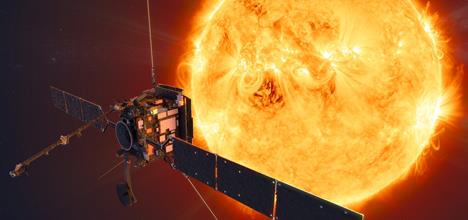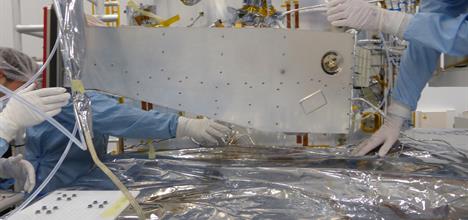Due to launch in February 2020, Solar Orbiter will perform unprecedented close-up observations of the Sun. It will allow scientists to study the Sun in much more detail than previously possible and to observe specific features for longer periods than can be reached by any spacecraft circling the Earth. In addition, Solar Orbiter will measure the solar wind close to the Sun and provide high-resolution images of the uncharted polar regions of the Sun.
The UK has played a vital role in the conception and creation of this satellite, with STFC's RAL Space, University College London and Imperial College London leading international teams to design and build three instruments. UK scientists, including those from RAL Space, were instrumental in proposing the Solar Orbiter mission to ESA. The UK Space Agency funded the development of two out of the 10 scientific instruments on board the spacecraft, and contributed to a further two.

Science Minister Chris Skidmore said:
“I am delighted that the UK has played such a leading role in this mission to observe uncharted regions of the Sun. From mobile phones to electricity networks, our scientists will make new discoveries about the impacts of space weather on our daily lives.
“Our commitment to the European Space Agency means UK research and engineering teams will continue to be at the heart of the new space age after we've left the EU, creating highly-skilled jobs and supporting our economy."
Solar Orbiter will carry 10 state-of-the-art instruments. Remote sensing payloads will perform high-resolution imaging of the Sun's atmosphere – the corona – as well as the solar disk. Other instruments will measure the solar wind and the solar magnetic fields in the vicinity of the orbiter. This will give us unprecedented insight into how the Sun works, and how we can better predict periods of stormy space weather, which are related to coronal mass ejections (CMEs) that the Sun throws towards Earth from time to time.
The Spectral Investigation of the Coronal Environment (SPICE) instrument, which was built by RAL Space, is a high resolution imaging spectrometer observing at extreme ultraviolet wavelengths. It will help solve one of the secrets of the Sun - where exactly does the solar wind come from and how does it speed up and escape from the Sun. RAL Space led the international consortium, under contract to ESA and with contributions from the UK Space Agency and other European countries.
RAL Space's Dr Andrzej Fludra, lead on the SPICE instrument consortium, said:
“Building SPICE has been a great achievement for our international team, led by RAL Space. For several years, engineers and scientists from the UK, France, Germany, Norway, Switzerland, the US and ESA worked closely together on specifying the science requirements, designing, building and testing the instrument.
“We are now getting ready to make observations of the Sun, preparing software and onboard procedures that will control the instrument. I have great hopes and expectations that we will be able to solve the remaining mysteries about the solar activity and how it affects the heliosphere."
From the spacecraft's unique vantage point, SPICE will carry out the first-ever spectral observations of the solar polar regions. SPICE will help trace solar wind structures measured at the spacecraft to their sources at the poles inside dark, slightly cooler areas of the Sun known as coronal holes.
By recording the 'fingerprint' at extreme ultraviolet wavelengths from a wide range of ionized atoms including carbon, neon, oxygen and iron, SPICE will measure the composition and speed of plasma flowing out from the Sun and help us find where it comes from. These ions are formed at temperatures from 10,000 to 10 million Kelvin, covering different layers of the solar atmosphere, from the chromosphere up to the corona.

Chris Lee, Chief Scientist at the UK Space Agency, said:
“Solar Orbiter is the most important UK space science mission for a generation, both because of its leading roles for UK science and industry but also because of the crucial information it will give us about living near a star like the Sun. It has never been more important to understand this interaction because of the impact space weather can have on our satellite enabled economy."
Solar Orbiter, which will take just under two years to reach its initial operational orbit, will follow in the footsteps of NASA's Solar Parker Probe, which launched in 2018. The two missions will offer complementary perspectives of the Sun – Parker Solar Probe will travel through the Sun's atmosphere, while Solar Orbiter will observe the surface.
The UK is a global leader in solar science with organisations like RAL Space working at the forefront of efforts to understand our nearest star and assess and mitigate the impact of space weather on Earth.
As well as leading instrumentation for science missions like ESA's Solar Orbiter and NASA's STEREO mission, RAL Space is leading an international team developing instruments for ESA's Lagrange mission which will be part of an early warning system for severe space weather and working with the Natural Environment Research Council on a new £20 million fund to connect the space weather research community with the Met Office Space Weather Operations Centre.
-Ends-
Notes:
Image credits:
Image 1: Artists impression of Solar Orbiter. Credit: ESA/ATG medialab
Image 2: SPICE being mounted to Solar Orbiter. Credit: Airbus Defence and Space
UK involvement
UK teams from University College London, Imperial College London and the Science and Technology Facilities Council's RAL Space are involved in 4 out of the 10 instruments. The UK Space Agency is funding the UK involvement.
· SWA (Solar Wind Analyser) uses three sensors and a processing unit to measure the different elements of the solar wind and characterise their behaviour under different solar conditions. As Principle Investigators, MSSL of the University of College London led the development of this instrument suite and built one of the sensors.
· MAG (Magnetometer) comprises two sensors located on a deployable boom in the shadow of the spacecraft, i.e. away from the Sun and an electronics box within the spacecraft body, enabling in situ sampling of the magnetic field and providing important diagnostic information. Imperial College London have led the development of this instrument.
· EUI (Extreme Ultraviolet Imager) is a suite of imaging telescopes that will provide images of the hot and cold layers of the solar atmosphere and of the solar corona showing the dynamics in fine detail and providing the link between the solar surface and outer corona. MSSL of the University College London is a Co-Investigator for this instrument.
· SPICE (Spectral Imaging of the Coronal Environment) is a telescope with a grating spectrograph and two active pixel sensor detectors that will provide images of the solar disk and corona. SPICE will be able to study features both on the surface and out in the corona and to look at the connection between them. RAL Space, part of UK Research and Innovation, leads an ESA funded consortium that developed and built this instrument. The UK Space Agency contributed one of the subsystems to SPICE.
· Engineers at Airbus Defence and Space UK have designed and built the spacecraft to withstand the scorching heat from the Sun that will hit one side, while the other is frozen as the orbit keeps it in shadow. The design is based on ESA's BepiColombo mission to Mercury, the closest planet to the Sun, which launched in 2018 with significant involvement from UK engineers and scientists.
